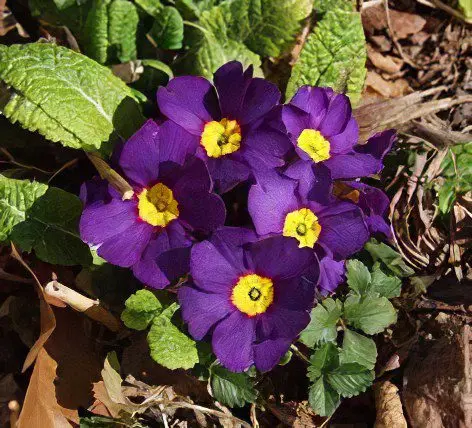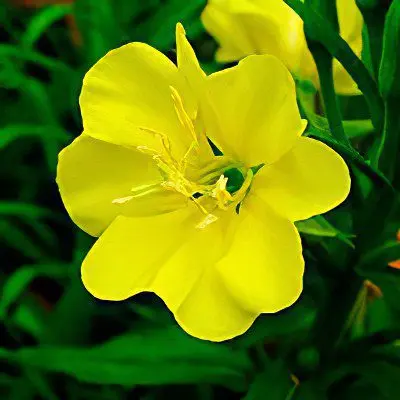The benefits of primrose oil and the care of evening primrose, garden
Botanical characteristics of primrose

Primrose is a perennial plant, the height of the stems of which rarely exceeds 25 cm. The root system of the primrose is fibrous, and the wrinkled leaves are ovate-oblong with crenate edges. The yellow flowers are about 2 cm in diameter. There is an orange spot in the throat of each flower. The flowers are collected in elegant umbellate inflorescences. Primrose blooms in April and May for about 40 days. The fruit of this beautiful plant is presented in the form of a box. You can meet the primrose in Russia almost everywhere, as well as in Europe and the Crimea.
Useful properties of primrose
Such a wonderful plant as primrose boasts a diaphoretic, diuretic, expectorant and tonic effect. This vitamin plant helps to improve the functions of the adrenal glands, and also normalizes the process of secretion of gastric juice. It should be recalled that the aerial part of the primrose with charming flowers has been used in folk medicine since ancient times. This plant contains large amounts of phenolic glycosides and saponins. Primrose roots boast the presence of essential oil and glycosides. All parts of the presented plant contain ascorbic acid, indispensable for the human body. In addition, carotene was found in the roots and leaves of primrose.
The use of primrose
Due to the high content of vitamin C, primrose is used in the form of salads for food. Along with this, dried raw plants are prescribed for influenza, acute respiratory infections, tonsillitis, hay fever, bronchitis and rhinosinusitis. This herb has a weak hypnotic and sedative effect, and is also effective for neuroses and migraines.
Primrose infusion: To prepare the infusion of primrose, you need to take 4 tablespoons of raw materials and pour them with 500 grams of boiling water. It is recommended to insist the mixture in a thermos.
primrose oil
Popular primrose oil helps restore immunity, is effective in menopause and painful menstruation. Such a remedy perfectly fights dyshormonal conditions in both women and men, increasing the level of sex hormones. Primrose oil is often used for the rehabilitation of a person after intoxication and severe infectious diseases. It perfectly fights high blood pressure, and is also effective in cardiovascular diseases and angina pectoris.
Primula: planting and care at home

Primula is an actual and fairly common plant with amazing flowers of very different colors. At home, primrose is picky and does not require much effort to grow. Such an interesting plant loves well-lit places, but does not tolerate direct sunlight at all. Before planting, evaluate the condition of the soil: it may need to be fertilized. A weak slurry would be the best option.
Primula at home prefers a temperature of about 10 ° C, in this case it will bloom perfectly. In addition, she likes well-drained, but not waterlogged soil. Dry soil can lead to the inevitable death of the plant. Watering is carried out carefully, without falling on the leaves.
Perennial primroses are recommended to be transplanted once a year in September into another soil. A shallow wide pot is perfect for transplanting. Reproduction of primrose is carried out with the help of seeds, and division of the plant bush into parts is also possible. Proper care of primrose is a guarantee of excellent flowering.
primrose seeds
Freshness and quality of seeds are the key factors for successful breeding of primrose. In addition, the peculiarities of the awakening of seeds should be taken into account. Some varieties germinate quickly and without problems, while others behave unpredictably.
Primrose seeds respond well to stratification. Some species should be sown “before winter”. To make the seeds of the plant feel good, opt for a low box with holes in the bottom.
primrose flowers
Primrose flowers are usually large, their size ranges from 2 to 6 cm in diameter. Single flowers are collected in elegant inflorescences. An infusion of the flowers of such a unique plant is great for migraines, chronic constipation and fatigue. To prepare it, you should take 25 grams of primrose flowers and brew them with 200 ml of water. Half an hour after such a procedure, it is recommended to strain the mixture. Take half a glass of infusion 2-3 times a day.
Primula garden
Garden primrose is in demand among many flower growers due to its beautiful flowers and simple care. The colorful flowers often grow in small groups, delighting in a wide variety of shapes and amazing aroma. Garden primrose prefers good, fertile soil that has plenty of organic matter.
Regular drainage is very important for this plant. In order for the roots of the primrose to grow well, water the plant once a week in the absence of rain. A cool place, diffused lighting and low temperatures – this is what the garden primrose likes. Do not forget to also protect the plant from winter frosts.
Primrose room
Indoor primrose is an amazingly beautiful plant that blooms in early spring, delighting everyone around with its flowers. The leaves are presented in the form of a basal rosette. If you want the primrose to bloom all year round, provide it with coolness, bright light and a sufficient supply of fresh air.
In room primrose in June, a dormant period begins. In the summer months, it is recommended to put it in the garden or on the balcony. Primrose will appreciate frequent feeding. However, it should be noted that flowers should not be sprayed with water and various nutrient solutions. This type of plant propagates by seeds or planting bushes.
Primula terry
Double primrose is a chic perennial plant that is known for its magnificent flowering. This species forms an even compact bush, the height of which does not exceed 20 cm. Whole basal leaves are complemented by large double flowers of various shades. This plant grows well and blooms profusely in slightly dark places and on fertilized soils. Seeds must be sown in open soil in spring, but can also be done in autumn. Seedlings appear around the 25th day. In the second year of the plant’s life, flowering will begin, the duration of which is 4 months – from April to August.
Evening primrose

Evening primrose is a perennial plant whose flowers bloom only at night. This plant is considered a storehouse of nutrients. Evening primrose oil is rich in various fatty acids and trace elements that have a beneficial effect on skin condition.
Evening primrose is indicated for infertility, hormonal failures, menopausal disorders, low vision, diseases of the nervous system, and cardiovascular ailments. Along with this, such a plant is used to rejuvenate the skin, improve the immune system and quickly relieve pain.
evening primrose during pregnancy. For a future mother and her child, such a plant is simply irreplaceable. It perfectly restores the hormonal background and increases the elasticity of the ligaments for an easy flow of labor. The polyunsaturated fatty acids contained in the plant perfectly stimulate the activity of the fetus, contributing to the full development of the nervous system.
Contraindications to the use of primrose
Primrose is contraindicated in pregnancy and individual intolerance. In addition, allergic reactions may occur when using this plant.









